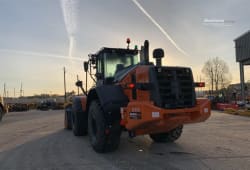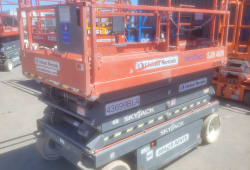Navigating the Powerful Machinery Behind Construction and Mining Operations
9 Min read
)
January 27, 2024
In the dynamic realm of construction and mining, the backbone of efficient operations lies in powerful machinery designed to tackle the toughest tasks. In this exploration, we delve into the critical role played by specific equipment in both mining and construction scenarios. Let's uncover the prowess of Motor Graders and Wheel Loaders in mining operations, followed by an examination of Excavators and Backhoes as indispensable tools in the construction industry.
The Evolution of Heavy Machinery
The evolution of heavy machinery in construction and mining is a riveting journey through time, marking significant strides in technology and engineering. In the early days of these industries, manual labour and basic tools were the backbone of construction and mining efforts. However, as the demands for efficiency and productivity intensified, so did the need for more robust and specialized equipment.
The industrial revolution heralded a new era, introducing steam-powered machinery that revolutionized excavation and transportation. The transition to diesel engines in the early 20th century further amplified the power and versatility of heavy machinery. Bulldozers, excavators, and cranes emerged as pivotal players on construction sites, while mining operations benefited from innovations in drilling and extraction equipment.
In recent decades, the integration of advanced technologies has propelled heavy machinery into the digital age. GPS-guided systems, telematics, and automation have enhanced precision, safety, and overall efficiency. This evolution continues, with ongoing research and development paving the way for smart, connected, and environmentally sustainable machinery. Today's construction and mining equipment stands as a testament to human ingenuity, reflecting a commitment to progress that has shaped and reshaped the landscapes of our world.
The Anatomy of Construction Machinery
The anatomy of construction machinery unveils a complex and purposeful design tailored to the demands of diverse construction tasks. These mechanical giants consist of several key components working seamlessly to execute precise and powerful operations.
At the heart of construction machinery are engines, providing the necessary power to drive the equipment. Transmissions and hydraulic systems facilitate the conversion of this power into controlled movements, allowing for the finesse required in construction projects. The chassis, a sturdy frame supporting the entire structure, provides stability and durability on the job site.
The arms, booms, and buckets form the appendages of construction machinery, each serving a specialized purpose. Excavators boast versatile arms and buckets for digging and lifting, while cranes feature extendable booms for reaching great heights. Loaders, with their front-mounted buckets, efficiently handle materials on the ground.
Tracks or wheels, depending on the machinery type, enable mobility across varied terrains. Tires provide agility and speed for certain equipment, while tracks offer stability and weight distribution for heavy-duty tasks. Operator cabs, equipped with controls, instrumentation, and ergonomic features, serve as command centres, ensuring efficient control and visibility.
Understanding the intricacies of the anatomy of construction machinery is paramount for operators, maintenance personnel, and enthusiasts alike. Each component plays a crucial role in achieving the precision and efficiency required in the dynamic world of construction.
Unveiling the Powerhouses in Mining Operations
:format(webp))
Unveiling the powerhouses in mining operations takes us into the heart of an industry reliant on robust and specialized machinery designed to conquer the formidable challenges of extracting valuable resources from the Earth. Mining operations are synonymous with power, and the equipment employed in this sector stands as a testament to engineering marvels dedicated to efficiency, durability, and productivity.
Haul trucks, giants of the mining world, are the workhorses responsible for transporting vast amounts of material from excavation sites. These colossal machines showcase immense hauling capacities, enabling the movement of minerals on an unprecedented scale. Drilling rigs, equipped with powerful drills and precision control systems, pierce through layers of earth to extract core samples or access mineral deposits.
Crushers, another essential component, break down large rocks into manageable sizes for further processing. Their formidable strength and efficiency streamline the mineral extraction process. Beyond these, mining operations also rely on loaders, dozers, and shovels, each tailored to specific tasks, creating a symphony of coordinated efforts to extract, transport, and process valuable minerals.
Understanding the powerhouses in mining operations underscores the integral role heavy machinery plays in transforming resource-rich landscapes into essential materials for various industries. These mechanical behemoths not only define the efficiency of mining endeavours but also exemplify the ceaseless pursuit of innovation within the mining industry.
Cutting-edge Technology in Construction and Mining
Cutting-edge technology in construction and mining is reshaping industries that have long been defined by their reliance on powerful machinery. In both sectors, technological innovations are propelling efficiency, safety, and sustainability to unprecedented heights.
One notable advancement is the integration of GPS-guided systems, allowing for precise navigation and operation of construction and mining equipment. This technology enhances accuracy in excavation, grading, and surveying tasks, contributing to the overall precision of projects. Autonomous vehicles have also entered the scene, with self-driving trucks and bulldozers revolutionizing the landscape of construction sites and mine pits.
Telematics systems play a pivotal role in equipment management, providing real-time data on machinery performance, fuel consumption, and maintenance needs. This data-driven approach enables proactive decision-making, optimizing operations and reducing downtime.
Furthermore, the implementation of artificial intelligence (AI) in predictive maintenance enhances the reliability of heavy machinery. AI algorithms analyze data patterns to predict potential equipment failures, allowing for timely interventions and preventing costly breakdowns.
The adoption of cutting-edge technology extends to environmental considerations as well, with innovations such as electrification and hybridization reducing emissions and minimizing the ecological footprint of construction and mining activities. As construction and mining continue to evolve, embracing these technological advancements not only improves operational efficiency but also positions these industries at the forefront of sustainable and intelligent resource utilization.
Mining Equipment
Mining operations demand specialized machinery to navigate challenging terrains and extract valuable resources efficiently. Two stalwarts in this domain are Motor Graders and Wheel Loaders.
Motor Graders in Mining
Motor graders, often unsung heroes in mining, play a crucial role in creating and maintaining roads within the mining area. These robust machines ensure that roads are properly graded and have adequate drainage, optimizing the efficiency of material transportation.
In the mining landscape, where even a minor delay can have significant consequences, motor graders prove instrumental. By addressing issues like debris and ponding water on roads, these machines contribute to the seamless flow of vehicles, ultimately enhancing the overall productivity of the mining operation.
Wheel Loaders in Mining
When it comes to swiftly moving vast quantities of material across a mining site, large wheel loaders take the spotlight. Their versatility spans from compact models ideal for light materials to larger counterparts capable of handling substantial loads, such as iron ore or rock.
The size of the wheel loader aligns with its load-handling capabilities, making it imperative to select the right model for the specific demands of the mining operation. With capacities ranging up to an impressive 38 cubic yards, wheel loaders become the workhorses of material handling in mining.
Construction Equipment
Transitioning from mining, the significance of powerful machinery also resonates in the construction industry. Excavators and Backhoes, with their multifaceted capabilities, stand out as indispensable assets in a construction project.
Excavators in Construction
Excavators, ubiquitous in construction sites, serve as versatile workhorses. Primarily designed for excavation, these machines extend their utility to heavy lifting, demolition, river dredging, and tree cutting. The long arm and rotatable cabin make excavators adaptable to various tasks, available in both wheeled and tracked forms.
Backhoe in Construction
The aptly named backhoe, with its hoe arrangement at the back and loading bucket in the front, epitomizes versatility. Excelling in excavating trenches and facilitating material loading, unloading, and lifting, backhoes prove invaluable in the dynamic landscape of construction projects.
In essence, the integration of these powerful machines into construction and mining operations signifies a commitment to efficiency, productivity, and precision. From maintaining roads in mining areas to excavating trenches on construction sites, these machines form the backbone of progress.
Conclusion
In conclusion, the exploration of powerful machinery in construction and mining unveils a saga of innovation, resilience, and progress. The evolution of heavy machinery from the manual labour of the early days to today's technologically advanced giants showcases the relentless pursuit of efficiency and productivity. The integration of cutting-edge technology, including GPS-guided systems, autonomous vehicles, and AI-driven predictive maintenance, propels these industries into the future, fostering not only operational excellence but also sustainability.
The anatomy of construction machinery, with its intricate components working harmoniously, highlights the engineering brilliance required to execute precise and powerful operations. Understanding the nuances of engines, transmissions, chassis, and appendages like arms and buckets becomes paramount for those operating, maintaining, or simply marvelling at these mechanical wonders.
Unveiling the powerhouses in mining operations emphasizes the colossal impact of machinery like haul trucks, drilling rigs, and crushers. These machines, with their immense capabilities, not only drive the efficiency of mining endeavours but also underscore the ceaseless pursuit of innovation within the mining industry.
The case studies of Motor Graders and Wheel Loaders in mining, along with Excavators and Backhoes in construction, exemplify the indispensable roles played by specific equipment in their respective domains. From creating and maintaining roads in mining to excavating trenches in construction, these machines epitomize efficiency, productivity, and precision.
As we stand at the crossroads of traditional power and cutting-edge technology, the powerful machinery behind construction and mining operations remains the cornerstone of progress, shaping landscapes and laying the foundation for a future where innovation and sustainability coalesce.














